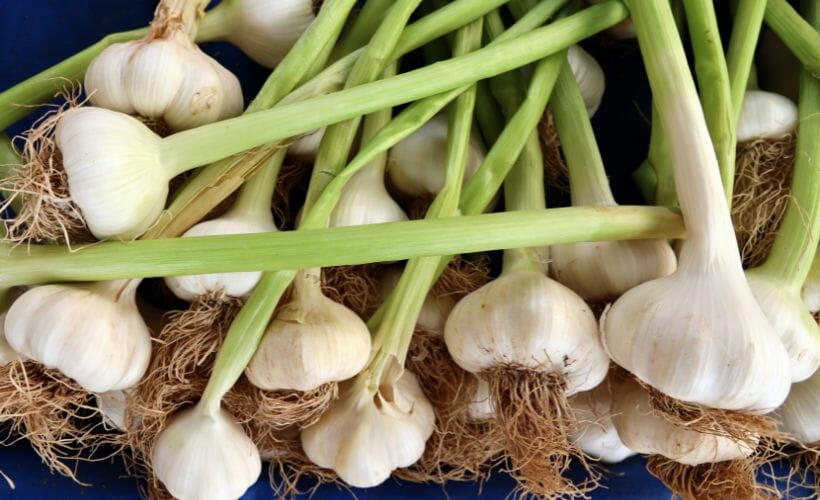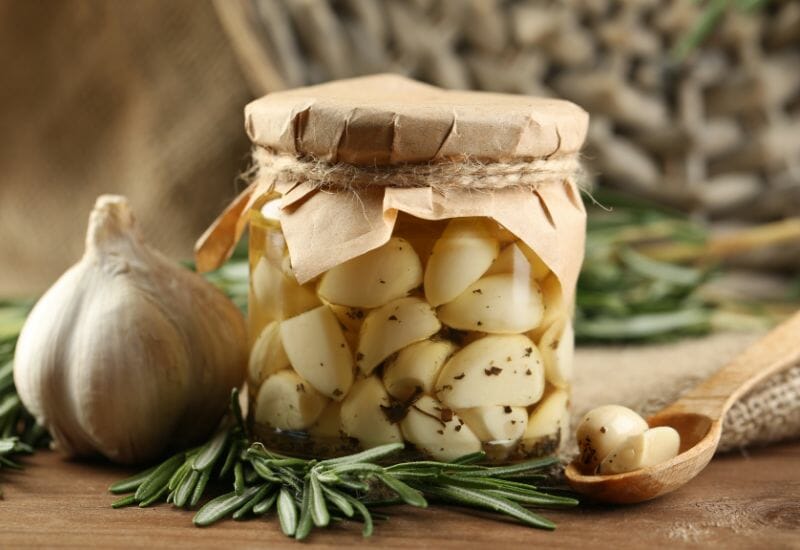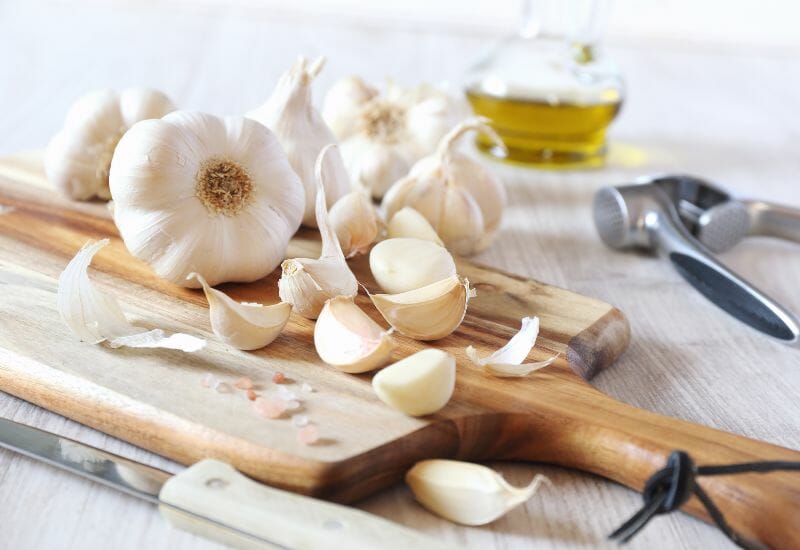How to Preserve Garlic for Long-Term Storage
Learn how to preserve garlic at home by pickling, drying, freezing, and more. Enjoy your garden’s fresh garlic bounty all year long!
Estimated reading time: 6 minutes

The distinctive aroma and flavor of garlic make it a staple of many recipes, but you may not know that you can preserve garlic in several ways. Whether you have a surplus of garlic from your garden or want to save time and effort in the kitchen, it’s worth learning how to store garlic to keep it fresh longer properly. I will share six methods for preserving garlic: freezing, dehydrating, pickling, making garlic vinegar, garlic salt, and garlic oil. We’ll also explore the best ways to use and store garlic to keep it tasting delicious. With the right knowledge, you’ll never have to worry about having too much garlic – meaning you can enjoy its distinctive flavor in your favorite recipes for months to come.
Freezing Garlic
Perhaps the easiest way to preserve garlic is to freeze it. Just peel the cloves and place them in freezer bags in the freezer. Easier yet, place the unpeeled garlic in freezer bags and remove it as needed. The cloves become mushy when thawed with both these methods, but their flavor remains good.
Another method for freezing garlic is to chop it and wrap it tightly in plastic wrap. With this method, you can grate or break off small amounts of chopped garlic as needed, which is helpful for cooks who often must quickly throw a meal together.
You can also freeze garlic that has been pureed in oil. This is nice because the oil keeps the mixture from freezing solid, and can be spooned out as needed, another help for busy cooks. To make frozen garlic oil puree, place one part peeled garlic cloves in a blender or food processor and two parts olive oil. Puree the mixture, then immediately transfer it to a freezer container. Cover the container and place it in the freezer. Do not store the garlic oil puree at room temperature or in the refrigerator because the mixture can support the growth of Clostridium botulism bacteria.
Dehydrating Garlic
Dehydrating garlic is my favorite way to preserve it. You can store your dried garlic as chips or grind them to make your garlic powder. Real garlic powder tastes a million times better than store-bought powder.
To dehydrate garlic, peel the garlic, making sure to discard any bruised or damaged cloves. Cut the cloves in half lengthwise, place them in a food dehydrator, and follow the manufacturer’s instructions for drying.
You can dry the garlic in your oven if you do not have a food dehydrator. Make drying racks by stretching cheesecloth over the oven racks and securing it with toothpicks. Place the garlic on the racks, turn the oven to 140 degrees Fahrenheit for two hours, then lower it to 130°F until completely dry and crisp.
Pickled Garlic
Garlic pickles are delicious and a favorite in our home. They are a delicious and tangy treat that can turn a simple sandwich into a delicious experience. The sharp and pungent taste of garlic is mellowed and magnified by the tangy pickling juices.
To make pickled garlic, loosely fill a glass jar with peeled garlic cloves. Add enough red or white wine vinegar to cover the garlic, and then add about one tablespoon of sea salt per cup of vinegar. Dried (not fresh) herbs such as red pepper flakes, bay leaves, and oregano may be added to taste. Cover the jar with a tight-fitting lid and shake to distribute the salt and herbs. Refrigerator garlic pickles will remain almost indefinitely in the refrigerator if the garlic remains submerged in the vinegar.

Check out the garlic vinegar below to preserve your garlic for recipes instead of eating it as a snack.
Garlic Vinegar
To make garlic vinegar, take a bottle of white or red wine vinegar and drop in either whole or chopped garlic. Use as much garlic as you wish, as long as it is completely submerged in the vinegar. Place the bottle in a dark and cool spot and let it sit for a few days up to a week. The period the mixture sits depends on the intensity of flavor you desire.
Once the mixture has had enough time to infuse, strain out the garlic and pour the garlic-infused vinegar back into the bottle. Store your garlic vinegar in the refrigerator and use the vinegar and the garlic in salad dressings or any dish that requires both vinegar and garlic. Garlic vinegar will keep in the refrigerator for about four months. If mold develops, discard the mixture.
It’s amazing how combining two ingredients can produce such a flavorful mix. Adding garlic vinegar to a dish can instantly take it to an entirely different level, adding a delightful garlicky taste to every bite. The possibilities of incorporating garlic vinegar in cooking are endless. From dressings to marinades to cocktails and even desserts, garlic vinegar adds a unique flavor that is both pungent and subtle.
Garlic Salt
Garlic salt’s unique flavor and versatile nature make it a pantry staple for many home cooks. Perfectly balanced, the blend of dehydrated garlic and sea salt makes it one of the most used seasonings in the kitchen. I use it in my famous Flax Seed Cracker recipe.
To start, gather dehydrated garlic and sea salt. You’ll want to use one part garlic and four parts salt, but feel free to experiment with the ratio to find your perfect blend. Put the dehydrated garlic in a food processor or blender and pulse until it becomes powder. Then, mix the sea salt and pulse for a second or two to combine the two ingredients. Do not blend too long because it will cause the mixture to cake, making it difficult to use. Finally, store the garlic salt in an airtight jar, ensuring it’s sealed tightly between uses.
Garlic Oil
Fresh garlic and oil are a dangerous combination if left at room temperature. Because of garlic’s low acidity and oil’s lack of oxygen, they can cause botulism toxins to develop. However, peeled garlic cloves can be added to the oil and stored in the freezer for several months.
Commercially prepared garlic in oil contains a preservative to increase the acidity of the mixture and keep it safe. To make garlic-flavored oil at home, add dehydrated garlic to olive oil in a wide-mouth jar, screw on the lid, and place the jar in the refrigerator. If the olive oil turns solid, spoon it out. Be careful, however, to always use a dry spoon to prevent the introduction of bacteria.

Preserving garlic is an excellent way to extend the life of your garden’s harvest. With simple techniques and tools, you can enjoy its sharp, pungent flavor all year. From freezing to dehydrating to pickling and making garlic oil and vinegar, it’s easy to store garlic properly and keep it tasting fresh – no matter how much you’ve got.

